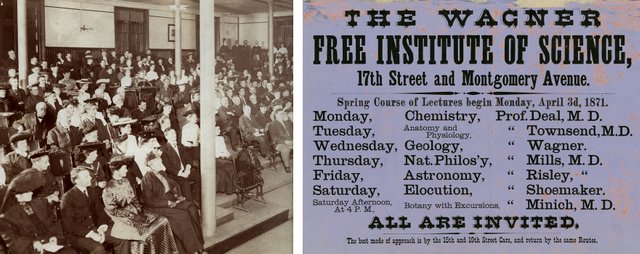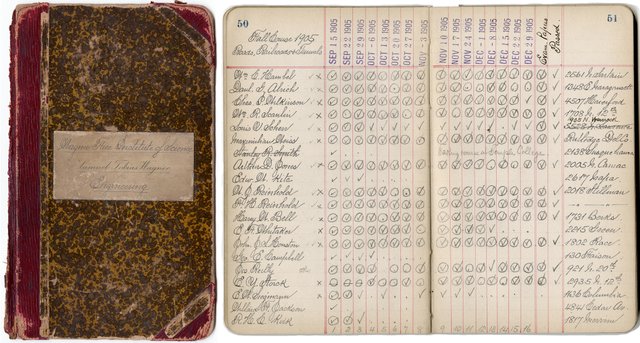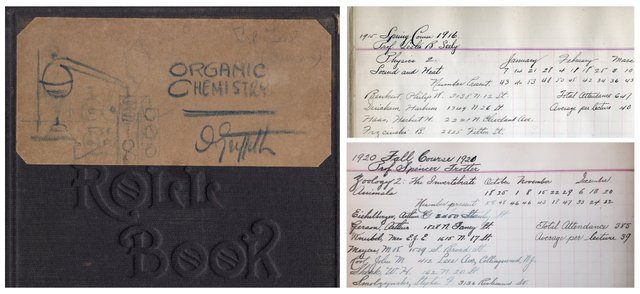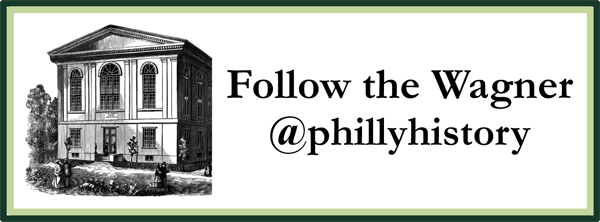Free and Open To All
The Wagner Free Institute of Science was born out of William Wagner’s love of the natural world, his belief in the importance of science education, and his knowledge that it was not accessible to the majority of the population in the 1850s. Wagner began giving lectures in Conchology, Geology, and Mineralogy in the early 1850s in his own home using specimens from his collections as teaching aids. The popularity of these lectures encouraged Wagner and he enlisted local college professors to expand the subjects offered.

Tickets to William Wagner's 1850s lectures. From the Scrapbooks of the Wagner Free Institute of Science.
On March 9th, 1855, the Wagner Free Institute of Science was formally incorporated. The Act of Incorporation states:
That the object of this institution shall be the gratuitous instruction in the Natural Sciences such as Geology, Mineralogy, Metallurgy, Mining, Botany, Chemical Agriculture, with their application to the arts and other kindred sciences to all persons.
This mission has been carried out in many different ways throughout our history. But the mainstay of our educational programming has always been these free college-level courses offered in the evenings each semester and open to all. 163 years later, we still offer free courses! Fall 2018 Course Schedule

Wagner Free Institute Lecture Hall, c. 1900 and a Broadside announcing the course of lectures for the Spring term, 1871. From the Scrapbooks of the Wagner Free Institute of Science.
One of the questions we get asked the most is ...
Who were the people taking these classes?
This is something we are also very interested in. Who was attending Wagner classes and where did they come from? Why did they come? For education, entertainment, both? Did people benefit from taking these course? If so, how? So many questions, but very few ways to find answers. And even more that can’t be answered at all.
So, where do we look to find these answers?
For the first 30 years of the Institute (1855-1885), the only source we have for this type of information is the Annals of the Wagner Free Institute of Science. The Annals are a diary-like account of the operations of the Institute kept by founder William Wagner, but often written in the third person. There are very few statistics, or hard facts present. At best, we get a sense of how William Wagner thought things were going. He often provides a general remark as to the size of attendance, often relating it to the weather.
Weather dry and mild, audience large, including a considerable number of Ladies, the Hall being crowded in every part.
or
Weather snowy and boisterous, audience thin.
But, this doesn't tell us anything about who the audience was, or even how many people were actually there. It wasn't until the 1890s that attendance records were kept. This began simply with recording the number of people in attendance for each class. Around 1900, the use of roll books expanded to include the names and addresses of students, as well as attendance.

The Roll Book for Engineering courses taught by Samuel Tobias Wagner. From the Archives of the Wagner Free Institute of Science.
This information helps answer the question of where Wagner students came from. Temple University-Wagner Institute Fellow Randall Rook delved into to this question during his research and produced a geospatial analysis of Wagner students with respect to Philadelphia’s population trends from 1905 to 1935. Rook gathered addresses from roll books in all subjects offered and mapped them alongside census data from the same years. His conclusion? During the first third of the twentieth century, the majority of students came from the three wards surrounding the Institute's neighborhood.

Roll Books for Organic Chemistry, Physics, and Zoology. From the Archives of the Wagner Free Institute of Science.
Still, none of this answers the questions of who these people were and why they were taking Wagner courses. Are there answers to these questions out there? Maybe in city records?
Maybe a future Wagner Fellow will delve into this research.
100% of the SBD rewards from this post will support continuation of fellowship program at the Wagner Free Institute of Science.

Good post! There are so many opportunities for further research.
Good post! There are so
Many opportunities
For further research.
- kenfinkel
I'm a bot. I detect haiku.
I love old ledgers and books like this. We have some from our family from mid Victorian time with meticulous lists of items ordered for a home being built and also some for household accounts, each line so well written and tallied. Life before the machine, truly amazing.
I love all the different handwriting styles. And how each professor has different methods of marking the attendance of each student.